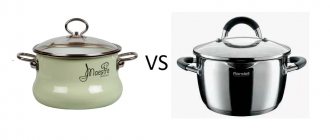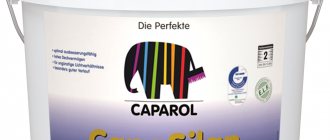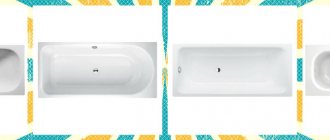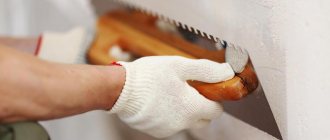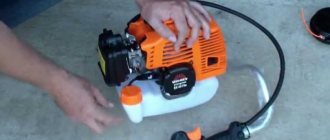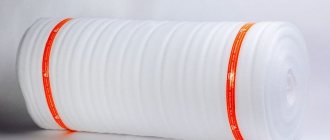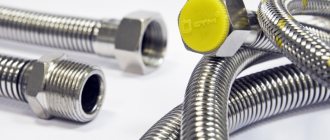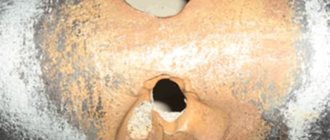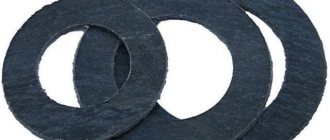How to choose a water liner? This is the question people ask when the work on installing plumbing equipment comes to an end. And this is an important point, since the water supply is the main link in connecting to the water supply. Reinforced hoses should easily supply water to any device (faucet, toilet, washing machine, etc.). The reliability of the eyeliner depends on many factors. But, first of all, it is the correct selection of the type of hose, as well as the quality of the manufacturing materials. Since the market exists many eyeliner models, then it’s not difficult to get confused when choosing them. Knowing the features of these parts will help you make the best purchase.
Until recently, connections to the water supply system were made exclusively from pipes. Often this installation method turned out to be extremely inconvenient: in cramped conditions in small bathrooms it is difficult to install rigid pipes. Therefore, an alternative was invented - a flexible hose line.
Unlike plastic or steel pipes, a soft hose has good flexibility, which is achieved through the use of elastic materials. In fact, this is an ordinary hose equipped at its ends with threaded fittings for connection to the water supply system.
The liner is versatile and serves to connect many plumbing fixtures, such as faucets, shower stalls, washing machines and toilets. When installing all of the listed plumbing fixtures, you cannot do without a flexible hose.
And although some craftsmen still use metal-plastic pipes when connecting, such a connection cannot be called reliable and convenient. In most cases, high-quality flexible liner will be easier to install and will last longer.
A flexible hose is also suitable for installing a hydraulic accumulator. It can also be used in places of constant vibration, for example, in pumping stations. Vibrating hoses withstand mechanical loads well.
Flexible hoses are especially useful when installing shower stalls. When cleaning the bathroom, you often have to move them aside to wash walls in hard-to-reach places. The hose makes this easy to do.
Tough
One of the most reliable options for connecting to the water supply network is a hard line. It is made of metal and is a tube. The production material can be:
- steel;
- copper;
- brass.
The method of installing a rigid line is to thread one side of the tube to the pipeline, and the other to the mixer. The metal structure easily withstands high temperatures, as well as exposure to detergents or mechanical loads, shock, friction, etc.
If installed well, rigid liner has the following advantages:
- resistance to rust;
- resistance to chemicals;
- long service life - about 20 years;
- ease of use.
The disadvantages may be the following:
- inability to move;
- complexity of installation.
Depending on the installation method, when connecting the line to the water supply system, additional adapters or special angle valves with connecting elements may be used.
Which option should I choose?
Experts recommend choosing the best option - a “semi-rigid” liner, which is a copper tube nickel-plated on the outside.
This type of connection is already equipped with standard fittings of different lengths for screwing into the body of the mixing valve. Collet adapters are screwed onto the other end of the semi-rigid tube with a rubber gasket around this tube. On the opposite side of the adapter there is a standard (HP or BP) ½ inch plumbing thread.
Connecting a semi-rigid line is very simple:
- The bodies of the collet adapters are installed at the outlet of the pipeline.
- Then you need to screw these semi-rigid tubes into the mixer and install it on the sink.
- Then you need to bend the liner to the desired place so that the tube does not fold, that is, with a large radius.
- After this, you need to mark the required length, put the conical part of the collet adapters on the tube and saw off the excess.
- Before sawing, do not forget to put on a collet clamp, otherwise you will have to file the tube for a long time and remove a long chamfer from it.
- Then the tube is inserted into the collet adapter bodies that are pre-screwed to the pipeline.
- Then you need to throw the conical parts onto the adapter and tighten them very carefully so as not to damage the rubber seals.
For installation, you only need three tools: an adjustable wrench, an open-end wrench from an auto-dialer, and a hacksaw (or a file with a sharp edge).
Semi-rigid liner, unlike flexible liner, does not need to be replaced every couple of years for preventive purposes, and is more resistant to hydraulic shocks and ruptures. By choosing this option, you will significantly increase the reliability of the connection, reducing the risk of rupture or leaks.
Flexible
Installation using flexible hoses is much simpler. The hose is perfect for connecting various types of plumbing equipment. The elastic connection even allows you to connect plumbing fixtures located at a distance from the water supply pipes.
Thanks to the flexible hose, you can install faucets anywhere in the bathroom, for example, at the edge of the bathtub or on the wall, in a corner, etc. Often, when you buy a faucet, the set is already equipped with rubber hoses for connecting to the water supply system. But in most cases, their length is not enough, so you have to purchase longer hoses.
Structurally, a flexible hose consists of a rubber hose of some length, the surface of which is braided with a metal jacket, which is necessary to increase strength. At the ends there are fittings for threaded connections. Provided that rubber is used, the hose is absolutely safe and environmentally friendly.
The service life of the flexible liner is quite long. During use, it does not emit harmful substances. The material itself withstands high temperatures, so the flexible hose can be used in hot water supply or heating. But it’s better to ask the store how to choose wiring for water with temperatures above +950.
The flexible hose can be equipped with a brass fitting; it is connected to the inlet using a special sleeve. Connections to the water supply system are made using fittings or union nuts.
The undoubted advantages of flexible eyeliner include the following:
- possibility of hidden installation. Flexible hoses can simply be hidden in in-wall boxes. Hidden installation is especially important when installing built-in faucets, then the hoses do not spoil the view;
- flexibility of the liner. During the installation of plumbing fixtures, you can freely move them around the bathroom area, and you don’t have to worry about the hose being damaged;
- simplicity and ease of installation and dismantling. All you need is a wrench and pliers;
- high quality and long service life;
- safety in use;
- ease of use.
However, flexible eyeliner has a number of disadvantages, for example:
- careless handling, mechanical damage, twisting and stretching lead to damage to the hose, which will result in leakage and flooding;
- bellows connections are noisy, especially when taps are opened simultaneously in different rooms;
- the metal jacket will oxidize over time and begin to rust;
- not all hoses can withstand the temperature of hot water;
- impossibility of installation near an open flame source.
Connection rules
The liner in different systems is connected through mounting elements at the ends of the hose - union nuts and fittings. The hose model is selected according to its length, type of connection and size of the mounting unit. Fittings are available in sizes from 0.5″ to 1.5″. The hose is attached freely, without tension. Otherwise, deformation of the pressed connecting fittings occurs.
For different diameters of the mixer and pipeline, the supply at one end is connected through an adapter.
During installation, you must follow the connection rules.
- Before installation in the liner, the fastening of the fittings at the ends is inspected, the presence of gaskets, the quality of the thread and braid are determined.
- After connecting, check for leaks within half an hour. When drops appear at the joints, tighten them.
- The bending radius should be more than 5–6 times the outer diameter.
- The hose is not stretched or twisted during installation.
- When tightening, do not apply excessive force: the seal may be damaged. If there is no experience, tightening is done by hand, followed by a slight tightening with a wrench.
- The hose cannot withstand open flame or high temperatures.
- Once every six months, the tightness of the fastening is checked and an external inspection of the liner is carried out.
- To avoid electrochemical corrosion, pairs of the same metal are connected.
- It is recommended to replace the liner every 5 years.
Criterion 1. Hose
A flexible line has a main component - a rubber or caoutchouc hose braided with a metal jacket. It is made from environmentally friendly rubber. When interacting with liquid, the hose does not decompose and does not release toxic substances. Therefore, flexible hoses can be used in drinking water systems. It is also quite resistant to the influence of hot water. The rubber hose can be used when installing hot water heating systems (up to +950). The main thing before purchasing is to make sure that the hose is designed for use in conditions of elevated temperatures. A sign of low-quality rubber is a strong chemical smell. EPDM material has virtually no odor.
History of invention
What is a bellows? This design was invented by an American meteorologist at the beginning of the last century. He came up with a corrugated metal container to trap air particles that could shrink and expand with changes in pressure. He gave the name to his invention from medieval mythology - the spirits of the air were called sylphs. The unique property of the bellows to maintain tightness even with multiple deformations has found wide application in a wide variety of industries. Bellows water line is one of the most common uses of this invention.
Criterion 2. Braid
Another important part of the eyeliner design is the metal braid. Its purpose is to provide increased strength and protect the soft hose from mechanical damage and water hammer.
- The shirt is made of stainless steel threads. An eyeliner braid from the middle price category lasts about 8 years. But in most cases, during this period the mixer is changed and the liner is changed in one thing. A metal jacket made of stainless steel threads can withstand water pressure of 10 atm and temperatures up to +950. The specified characteristics are operational; at peak load the liner can withstand higher pressure and temperature.
- The braid may also consist of aluminum threads. Eyeliners with this type of protective jacket do not last as long as their counterparts with stainless steel protection. The braid remains reliable for 3-4 years and can withstand pressure up to 5 atm. Aluminum threads are sensitive to condensation, which leads to oxidation and destruction of the metal. When purchasing, it is easy to identify aluminum braiding - you just need to rub it with your hand and a trace of aluminum will remain on the skin.
- The third type of protective jacket is made from galvanized wire. This type of braid is the most unreliable and is used in budget eyeliners. Its maximum operating pressure is 3 atm. Service life – no more than 2 years. Eyeliner with a galvanized jacket is usually used as a temporary one.
Sometimes you can find expensive, reinforced eyeliners on sale. Their braid is made of nylon or stainless steel threads. Such a shirt can easily withstand a pressure of 20 A) and a temperature of up to 1100. And the service life is at least 15 years.
Specifications
In the plumbing market you can find two different categories of flexible hoses - adapters and extensions. Adapters are ordinary hoses for supplying water to showers, sinks or washing machines. Their length rarely exceeds 0.5 m. Using an extension cord connected to the adapter, water is supplied to those areas that a conventional hose cannot reach.
The characteristics of eyeliners of the first and second categories are similar and look like this:
- the diameters of the outer and inner radius of the pipe are 12 and 11.5 mm, respectively;
- the nominal pressure is 8 bar, and the maximum reaches 10 bar;
- the minimum bending radius is 60 mm;
- maximum permissible temperature of 70 degrees;
- service life is at least 10 years;
- rubber hose hardness 75 Shore;
- The maximum tightening torque for the fittings at the ends of the hose is 50 Nm.
Criterion 3. Connection
High-quality crimping of the tip is a good indicator of the reliability of the entire liner. The tip is one of the most important parts of the structure. The service life of the liner and its safety depend on the quality of its manufacture and crimping.
One type of defect is weak compression of the braid. This can happen either due to poor-quality liner material, or due to the lack of special equipment at the manufacturer.
Manufacturing tips and connections from low-grade metal is fraught with deformation, rapid oxidation and corrosion, which ultimately leads to structural failure. Connections can be:
- brass LS-59 coated with nickel-chrome - lasts up to 15-20 years;
- made of stainless steel AISI-304 without protective coating - lasts up to 15-20 years;
- made of ordinary steel, coated with nickel-chrome - lasts up to 1-3 years. To determine the type of metal, just scratch the surface of the braid. If it is made of plain steel, the scratch will be silver, and if it is made of brass, it will be silver-yellow.
Choosing the right mixer is the key to long-term and convenient use of the product.
When purchasing a mixer, you should pay attention to:
- the material from which it is made;
- sealing parts;
- spout type
High-quality faucets are made from bronze or brass. Their main difference is the yellow spout neck of the device. If the neck is gray, then the mixer is made of silumin. This material wears out quickly due to corrosion.
The sealing elements must be rubber. The mixer kit must include a split spout spacer ring. Some unscrupulous sellers claim that it does not need to be installed. But that's not true. The absence of a spacer ring will cause the mixer to become loose and leak.
As for the type of spout, it is better to purchase a faucet with a swivel spout for sinks. This is explained by the fact that models whose spout does not turn are inconvenient to use. Often the stream of water hits the edge of the sink or flows down its edge. And you won’t be able to wash your face properly when water is pouring into one point.
Criterion 5. Fitting
Looking inside the hose, you can see a brass fitting. Its presence is an indicator of high-quality eyeliner. In counterfeit products, fittings/nipples are often made of plastic, which is unacceptable.
The fitting is made only from stainless steel, plain or nickel-plated brass and aluminum.
Low-grade metal should not be used in the manufacture of the nipple, and the thickness of the product should not be lower than permissible. Otherwise, these shortcomings will lead to rapid failure of the entire flexible line.
What to look for when purchasing
Alas, sellers often keep silent about the shortcomings of the product and it’s possible to make a mistake even if you know what characteristics of a flexible liner are needed in a particular case. However, there are also “tricks” that will help distinguish low-quality products from really good plumbing connections. What to pay attention to:
- Labeling. The liner for cold water is marked in blue, and the line for hot water in red. If the braid has “threads” of both colors, the product is universal, which is necessary for connecting faucets, showers, and washing machines, where the temperature options are different. PVC coated eyeliner is not marked blue/red. On such connecting elements, the characteristics are written in text, in the form of permissible temperatures and pressures. If there is no marking at all, you have a low-quality product. It’s pointless to talk about any of its merits and discuss how long it will last or not.
- Weight. The braid cannot be weightless - even modern products in which metal is replaced with polymer are lighter, but not so much that the weight is not felt. If the product is lightweight, the manufacturer has saved on reinforcement. The strength and resistance to aggressive factors of such products is questionable.
- Flexibility. If the seller is confident in the quality of the product, he will demonstrate that the hose can be “tied into a knot” without damaging the rubber. The second way to ensure elasticity is to let the eyeliner “hang” under its own weight. It should straighten out quickly and not look like a serpentine.
- The smell. A “rubbery” persistent aroma is a sign that toxic material was used to produce the hose. Modern rubber is non-toxic, environmentally friendly, and even when heated it is not hazardous to health, so the absence of odor is one of the proofs that the flexible liner is of high quality.
It is ideal to have a trusted specialist help you when choosing connections. If you don’t have such a specialist among your friends or acquaintances, and purchasing flexible eyeliner is necessary, our consultants will be happy to help you choose products that will last for decades, taking into account your budget.
Criterion 6. System temperature and pressure
To correctly answer the question - how to choose a flexible water supply - you also need to pay attention to the technical parameters of the plumbing system. This is, first of all, pressure in the pipes and water temperature. If the eyeliner does not meet the indicators, it will quickly become unusable.
While you can always determine the water temperature yourself, it is quite difficult to find out the pressure parameters in the system. If it is impossible to determine specific indicators, then you can focus on standard figures characteristic of all water supply systems.
- Central water supply - 4 atm.
- Closed heating system with coolant circulation - 1.5-3 atm.
- Centralized heat supply - 2-4 atm.
In the case of heat supply, peak loads are possible, so when making calculations it is better to include a plus of 20-25%.
Methods for attaching a faucet to a sink
There are two main methods for installing mixing fixtures on sinks or sinks, which are inherent in their design.
Mixers are attached to kitchen sinks in the following ways:
Using pins. The valve body for this installation is equipped with an additional threaded hole into which a pin with an external thread is screwed. To connect it, use a flat screwdriver, which is inserted into the slot at its end.
After screwing the threaded rod and flexible hoses, the mixer is inserted into the sink hole, an arc plate with a rubber seal is placed on the stud and clamped with a union nut. The mounted nut is rotated with a socket or open-end wrench.
It is worth noting that a similar fastening system is widely used not only in budget mixing devices of domestic and Chinese production, but also in expensive European models.
Criterion 8. Dimensions
When determining the dimensions of the eyeliner, it is important to know two main parameters:
- diameter. When choosing it, you need to focus on the expected water consumption. Standard values for various equipment: for installing a toilet - 8 millimeters, for connecting a faucet in the kitchen - 10 millimeters, in a bathroom - 15 millimeters;
- length. When choosing the length, the distance from the plumbing equipment to the water supply pipe is taken into account. The hose should not be stretched or bent too much. Any mechanical deformation will shorten the service life of the liner.
Bellows liner for water.
It consists of flexible bellows tubes with design features.
The advantages include:
- Reliability in operation
- Much longer service life compared to reinforced structures.
- The bellows liner is also very flexible. The design consists of assembled stainless steel rings of different diameters.
This eyeliner comes in two types:
- The first type is folding. It has the ability to stretch in the ranges specified by the manufacturer: from 200 to 355 mm. and from 140 to 250 mm. To avoid reducing service life, care should be taken when stretching.
- The second type is a fixed bellows connection for water supply. Does not stretch and has a certain length. Minimum length 10 cm. Maximum length 80 cm. Manufacturing step 10 cm.
The main negative property of such a liner is the hum that occurs when water flows to many products at once. For example, water is supplied to several plumbing units at once. To avoid this drawback, you should purchase an insulated bellows liner. Or use special anti-vibration types of liners that absorb sound.
